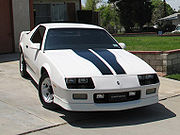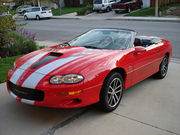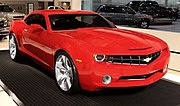Chevrolet Camaro: Difference between revisions
m BOT - Reverted edits by 66.37.64.6 {vandalism} to revision #168314081 by "72.16.112.91". |
|||
| Line 33: | Line 33: | ||
[[Image:1970ChevroletCamaroZ28.jpg|right|180px]] |
[[Image:1970ChevroletCamaroZ28.jpg|right|180px]] |
||
Introduced to market in February 1970, the [[second-generation Chevrolet Camaro]] would be in production for a total of 12 years. The car grew somewhat larger and wider with the new styling, thus resulting in a heavier car.<ref name="EdmundsHistory">{{cite web |url=http://www.edmunds.com/insideline/do/Features/articleId=66170 |title=A Chevrolet Camaro History |accessdate=2007-01-05 |last=Huffman |first= John Pearley |date=2003-06-16 |format=HTML |publisher=[[Edmunds.com]] |language=English}}</ref> Still based on the [[GM F platform|F-body platform]], the new Camaro was engineered much like its predecessor in that it still used a unibody structure with a front subframe, leaf springs in the back and A-arms up front for suspension. The car would see major changes in both styling and performance as time progressed from the introduction through the end of second-generation production in 1981. |
Introduced to market in February 1970, the [[second-generation Chevrolet Camaro]] would be in production for a total of 12 years. The car grew somewhat larger and wider with the new styling, thus resulting in a heavier car.<ref name="EdmundsHistory">{{cite web |url=http://www.edmunds.com/insideline/do/Features/articleId=66170 |title=A Chevrolet Camaro History |accessdate=2007-01-05 |last=Huffman |first= John Pearley |date=2003-06-16 |format=HTML |publisher=[[Edmunds.com]] |language=English}}</ref> Still based on the [[GM F platform|F-body platform]], the new Camaro was engineered much like its predecessor in that it still used a unibody structure with a front subframe, leaf springs in the back and A-arms up front for suspension. The car would see major changes in both styling and performance as time progressed from the introduction through the end of second-generation production in 1981. |
||
{{clear}} |
{{clear}} |
||
Revision as of 16:00, 31 October 2007
| Chevrolet Camaro | |
|---|---|
 | |
| Overview | |
| Manufacturer | General Motors |
| Production | 1967–2002 2009- |
| Body and chassis | |
| Class | Pony car |
| Body style | 2-door coupe 2-door convertible |
| Platform | FR F-body (1967-2002) FR Zeta platform (2009+) |
| Related | Pontiac Firebird |
The Chevrolet Camaro is a "pony car" made in North America by the Chevrolet Motor Division of General Motors. It was introduced on 26 September 1966 as a 1967 model year and was designed as a competing model to the Ford Mustang. The car shared the platform and major components with the Pontiac Firebird, also introduced in 1967. Four distinct generations of the car were produced before production ended in 2002. A new Camaro is expected to roll off assembly lines in 2009.[1]
Origin
The Camaro was initially advertised on Top 40 AM radio stations of the day in an attempt to woo the young adult market. Although it was technically a compact car (by the standards of the time), Camaro may also be classified as an intermediate touring car, a sports car, or a muscle car.
Though the car's name was contrived with no meaning, GM researchers reportedly found the word in a French dictionary as a slang term for "friend" or "companion." In some automotive periodicals before official release, it was code-named "Panther", however, the project designation for the Camaro was XP-836 and some early GM photos show the final Camaro body labeled "Chaparral".[2] Automotive press asked Chevrolet product managers "What is a Camaro?", and they were told it was "a small, vicious animal that eats Mustangs".[3] The name conveniently fit Chevrolet's "C" naming structure that included Corvair, Chevelle, Chevy II, and Corvette.
First generation

The first-generation Chevrolet Camaro debuted in September 1966, for the 1967 model year, on a brand new rear-wheel drive GM F-body platform and would be available as a 2-door, 2+2 seating, coupe or convertible with a choice of inline-6 and V8 powerplants. Concerned with the runaway success of the Ford Mustang, Chevrolet executives realized that their compact sporty car, the Corvair, would not be able to generate the sales volume of the Mustang due to its radical rear-engine design, as well as declining sales, partly due to bad publicity from Ralph Nader's book, Unsafe at Any Speed. Therefore, the Camaro was touted as having the same conventional rear-drive, front-engine configuration as Mustang and Chevy II. In addition, the Camaro was designed to fit a variety of power plants in the engine bay. The first-generation Camaro would last until the 1969 model year and would eventually inspire the design of the new retro fifth-generation Camaro.
Second generation

Introduced to market in February 1970, the second-generation Chevrolet Camaro would be in production for a total of 12 years. The car grew somewhat larger and wider with the new styling, thus resulting in a heavier car.[4] Still based on the F-body platform, the new Camaro was engineered much like its predecessor in that it still used a unibody structure with a front subframe, leaf springs in the back and A-arms up front for suspension. The car would see major changes in both styling and performance as time progressed from the introduction through the end of second-generation production in 1981.
Third generation

The third-generation Chevrolet Camaro was introduced for the 1982 model year. It continued to use General Motors' F-body platform and would produce a "20th Anniversary Commemorative Edition" for 1987 and "25th Anniversary Heritage Edition" for 1992. These were also the first Camaros with factory fuel injection, four-speed automatic transmissions, five-speed manual transmissions, four-cylinder engines, 16-inch wheels, hatchback bodies, and a rear window third brake light. It was during the third generation that the famous IROC Camaro (International Race Of Champions) was available, which included upgrades such as better flowing exhaust manifolds.
The third-generation Camaros would continue through the 1992 model year.
Fourth generation

The fourth-generation Chevrolet Camaro debuted for the 1993 model year on an updated F-body platform. It would retain the same characteristic since the first-generation's introduction back in 1967; 2-doors, 2+2 seating, available as a coupe or convertible (with the latter introduced in 1994), rear-wheel drive, and a choice of V6 and V8 powerplants. It featured the 5.7 L (350 cid) LT1 V8 engine that had been introduced in the Corvette one year earlier, as well as an optional six-speed manual transmission. The 1998 model year was refreshed and revised with both exterior and engine changes. Replacing the LT1 with GM's all-aluminum 5.7 L (346 cid) LS1 which had been introduced with the Corvette C5.
The fourth-gen Camaro would last up through the 2002 model year, at which point production of the F-Body platform was stopped due to slow sales, a deteriorated sports coupe market, and plant overcapacity.[5][6]
Fifth generation

On 9 January, 2006, the first official word regarding a fifth-generation Camaro from General Motors came at the 2006 North American International Auto Show, where the 2006 Camaro Concept was released.[7] The concept is powered by the 400 hp LS2 V8 and equipped with the T-56 six-speed manual transmission. GM also showed the 2007 Camaro Convertible Concept on 6 January, 2007 at the 2007 North American International Auto Show. The Camaro will be offered with both V6 and V8 engines, and have available automatic and manual transmissions. Pricing has not been officially announced yet, however, GM has stated that it will be competitive with the Ford Mustang. To be built at Oshawa Car Assembly in Ontario.
Racing
Camaros were one of the prominent vehicles in the Trans Am Series, and were in use in the league when last seen. Camaros have for years also been used in IROC. Third and Fourth generation Camaros are also currently raced in the SCCA American Sedan series and other SCCA classes. One of the most popular and dominant cars in NHRA Sportsman Drag Racing.
Appearances in pop culture
This article contains a list of miscellaneous information. (September 2007) |
Due to its persistent popularity and long production run, the Camaro has been referenced, shown, or used in nearly all forms of media since the introduction of the 1967 model.
The Camaro is referred to in a countless number of song such as Camaro Man by Blue Meanies, Bitchin' Camaro by Dead Milkmen, Camaro by Kings of Leon, The List by Metric, Wishlist by Pearl Jam, and "Teenage Dirtbag" by Wheatus. Bruce Springsteen, a lifelong fan of Chevrolets, refers to the Camaro in Racing In The Streets.
The vehicle mode of the character Bumblebee in the 2007 film, Transformers, is first a 1977 model Camaro and later a fifth-generation concept variant.
Top Gear's American fly-drive special featured a third-generation Camaro, bought by presenter Jeremy Clarkson for US$800 in Miami. During the filming, Clarkson became rather attached to the car, at one point stating that "I'd rather be in this now than an Enzo."[8]
Various models of the Camaro have been featured in game series such as Forza Motorsport, Gran Turismo, L.A Rush, Midnight Club 3: DUB Edition Remix, Need for Speed series, and Sega GT 2002.
References
- ^ General Motors (2006-08-10). "Auto Buyers Have Spoken: GM Will Build An All-New Chevrolet Camaro" (html). GM Media Online. Retrieved 2006-12-27.
- ^ "Chevrolet Camaro History" (html). Retrieved 2007-06-01.
- ^ Biggs, Henry (2006-02-03). "Top 10: Muscle cars" (html). MSN Cars UK. Retrieved 2006-12-27.
When asked, Chevrolet sales executives claimed a Camaro was a: "a small, vicious animal that eats Mustangs".
- ^ Huffman, John Pearley (2003-06-16). "A Chevrolet Camaro History" (HTML). Edmunds.com. Retrieved 2007-01-05.
- ^ Associated Press (2001-09-26). "Camaro, Firebird lines to end with 2002 model year" (html). Oklahoma City Journal Record. Retrieved 2007-06-01.
- ^ McCoy, Guy. "Rising from the Ashes" (HTML). Popular Hot Rodding. Retrieved 2007-08-04.
Publicly, GM blamed slow sales, a deteriorated sports coupe market, and plant overcapacity.
- ^ General Motors (2006-01-09). "Chevrolet Camaro Concept: Capturing the Timeless Spirit of Camaro" (html). GM Media Online. Retrieved 2006-12-27.
- ^ Top Gear Season 9 Episode 3.
External links
- Chevrolet Camaro Concept official Chevrolet site
- 2009 production announcement official GM press release
- Chevrolet Camaro at Curlie
